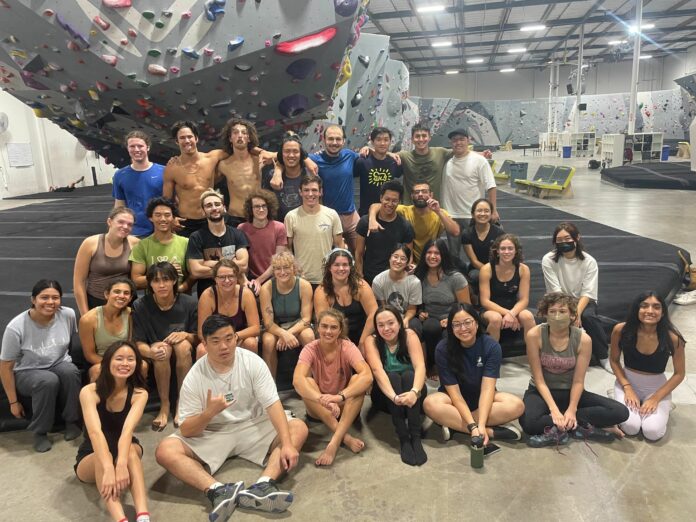The club welcomes students of all skill levels to socialize and stay active
By LYNN CHEN — features@theaggie.org
On campus, clubs and extracurricular organizations can fulfill a variety of passions and hobbies. For rock climbing lovers, they can find this in the UC Davis Climbing Club.
Members of the club practice both indoor and outdoor rock climbing. When they’re not training or hosting social events, Climbing Club members can also enter competitions to put their speed, strength, flexibility and technique to the test.
In addition to seasoned rock climbers, the club also welcomes beginners who have no prior experience with the sport and encourages them to learn alongside long-time members. These members act as coaches, providing instruction and advice to newcomers.
Typically, the club meets up three times a week to train at a climbing gym in Sacramento called The Boulder Field. Members of the club also enjoy the opportunity to practice outdoor climbing several times throughout the quarter — including places such as Bishop, Lake Tahoe or Castle Rock in the Bay Area.
During usual indoor training sessions, members primarily practice a form of the sport called “bouldering.” This is where climbing is done close to the ground, and ropes and harnesses are replaced by soft crash pads, used as safeguards for falling. Club members also familiarize themselves with different techniques to become more proficient climbers.
“There’s a strength threshold [involved in climbing],” Ethan Pang, Climbing Club co-coach and a third-year neurology, physiology and behavior major, said. “But you’re also learning all these different tricks and skills that don’t necessarily require a ton of strength once you [have] good technique.”
Hollis Allen, president of the Climbing Club and a third-year environmental science and management major, emphasized the importance of footwork as a technique as well.
The sport requires a lot more than upper-body strength and mobility alone, according to Allen. The way you engage your feet and legs is just as crucial.
“People when they start, they don’t think about intricacies like, ‘Where am I going to put my foot? How am I going to stand on this thing?’” Allen noted. “It’s about teaching people to use their feet and different parts of their body in ways that they haven’t really thought of.”
Each climb is considered a “problem” that needs to be “solved” over time, according to Pang. While figuring out how to navigate holds — shaped protrusions on climbing walls for people to grip — and achieve mastery over a specific wall, climbers grow mentally in the process.
Especially for people who are new to climbing, thinking out of the box and persisting is integral to becoming a skilled climber. Additionally, being strategic when approaching a climb is integral to being successful at completing it.
As a person’s energy is limited, they need to use the most efficient methods to complete a climb. Thus, the correct movements and tricks utilized during the process could make a substantial difference.
David Kuklin, a fourth-year communications major and general member of the club spoke on this statement further.
“[Understanding] how to go about a climb [beforehand] could be night and day for being able to do it and not do it,” Kuklin said. “I always say [climbing] is like chess in that you have to set your [moves] up so that it’s not necessarily that you can do the next step, but that you can do the next, next one.”
This process itself requires a lot of trial and error, and often climbers will have to give up on certain climbs repeatedly because of a particularly difficult section of the wall.
“It does feel bad,” Kuklin admitted. “It’s like, I wish I had thought of [the solution] ahead of time.”
Furthermore, Allen describes the disappointment and discouragement that beginners feel when attempting a new climb.
“Frequently, [when] new people will try something new, they’ll be like, ‘Oh, this is impossible, I can’t do it,’” Allen said. In response to this type of reaction, Allen encourages people to be resourceful and think of overcoming the problem through more creative approaches, such as engaging more parts of the body and using every part of the wall to your advantage.
Additionally, climbing is more social than people may realize, particularly for the UC Davis Climbing Club.
“Everyone [here] is very friendly, no matter what skill level you are,” Pang said. “I think a lot of people either initially started climbing or continue to climb because of the social aspect [to the sport].”
Walls associated with different difficulty levels of the sport are often connected, allowing people of all abilities to have more opportunities to mingle and connect with each other at the climbing gym.
“[Climbing] is pretty unique compared to other sports in that all skill levels can climb together,” Pang said.
Even though Kuklin is a relatively new member of the club, he also stated how he was looking forward to the social opportunities the club might offer him.
“I feel like as I explore [the club] more, I’ll have the opportunity to deepen some of the connections that [I’ve] already made,” he said.
In many ways, climbing pushes people to become better versions of themselves, whether that’s physically, mentally or socially.
“While climbing [has a very] tight-knit community, it’s primarily just a singular activity,” Allen said. “It’s a good way for me to grow as a person.”
Written by: Lynn Chen — features@theaggie.org





